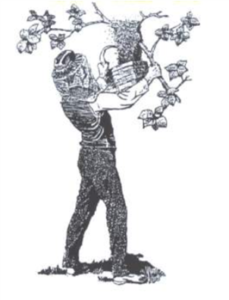At the April meeting (April 24) we knew of only a single swarm. Rich covered swarming in his comments and his comments will be posted in the meeting minutes. we should begin to hear of local bee swarms in May and June.
Swarming means different things to different individuals. Some beekeepers see swarms as a management failure, especially when the swarm issues from their colony. However many more view swarms as an opportunity to start a new colony. Swarm removal for some is a public service. Non-beekeepers may fear a swarm or view it as nuisance. Beekeepers, and non-beekeepers alike, see swarms as a curiosity.
Swarms are a great way to start a new colony. They are “free” when not counting your time. Swarms are available in spring when it is a good time to start a new colony. They are “easy” to capture, most of the time. Swarms are great wax producers when hived on foundation.
Swarming is basic – it is bee family reproduction. When successful, one colony becomes two or more colonies. It is the passing of genetic material on with creation of a new family. What we see as the swarm is the adult cluster, 10,000 or so bees, that have exited an established nest/hive to cluster at a temporary bivouac site. Swarming is the process of a colony dividing. Swarming takes about two weeks to complete.
Swarming is due to several interrelated factors. At the core, it is initiated by a lack of/failure in distribution of sufficient queen pheromone to the adult population in a colony. It may relate to total size of adult population and/or rearing of drones (or these may be coincidental relationships). Abundant nectar/pollen resources and environmental conditions may trigger or shut it down. Genetics definitely plays a role. Beekeeper intervention that removes brood &/or adult bees &/or expands the area for brood rearing in the hive or removal of the original queen/developing replacement queen (cells) may halt the behavior. Rich indicates (in minutes) how the 3 factors of queen, brood and space are keys.
It is difficult for beekeepers to detect when the bees have started swarming preparations. Our best signal is rearing of queen cells by spring expanding colonies. Swarm queen cells are usually attached to the lower comb margin of the brood sphere; in hives wit 2 brood boxes we look initially for cells built from upper combs between brood boxes. By the time we detect queen rearing we are at a disadvantage as the bees are often well into their swarming preparations. And since it is basic reproductive biology of bees, it is difficult to halt the behavior once it is in progress. We must perform extensive hive manipulations but een then success in halting swarming is not high in halting it.
Swarm capture can be a most pleasant experience or result in one heck of a story. The secret to swarm capture is getting the swarm queen into collection container so the bees follow her. Swarms (such as 2nd or 3rd swarms from the same colony) will often have multiple queens, making them difficult to capture. If the swarm cluster remains for a day or more at the bivouac site they can be uncharacteristically defensive (a dry swarm).
There is some risk associated with swarm capture. The bees in a captured swarm might be carrying “baggage” from their home colony such as mites or possibly disease. With all mites phoretic on the swarm adults, treatment with acids can reduce the mite load of a swarm upon hiving. While waiting for the first swarms, now is a good time to prepare a checklist of questions to ask when you hear of a swarm. Also assemble your ‘swarm capture kit’ (a good list of what to include in your ‘kit’ is on the SOBA website www.southernoregonbeekepers.org click on How to capture a swarm). If a member, sign up for swarm capture with WVBA and/or OSBA. Let the swarming begin!!
